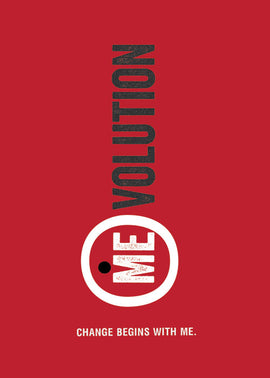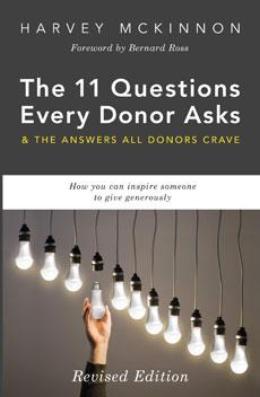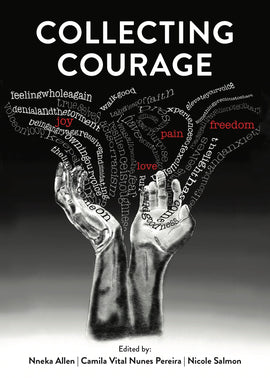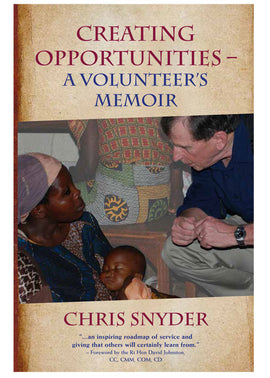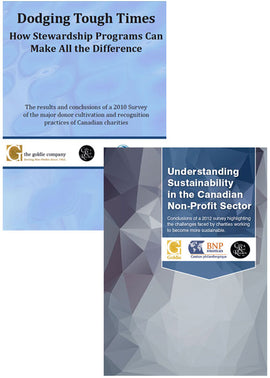What Your Donors Want...and Why eBook
What Your Donors Want...and Why eBook
Author: Tom Ahern
$22.00
What Your Donors Want...and Why eBook
The New York Times has called Tom Ahern one of the country's most sought-after creators of fundraising messages. He's also a hugely popular trainer, introducing fundraisers around the world to the secrets of persuasion and donor-centricity.
What Your Donors Want...and Why! is his latest and most impassioned book. In its chapters, nonprofits learn how to treat donors as customers, how to organize communications around the prime metric of Lifetime Value, and how to answer the Big Three questions required in a high-performance case for support. What Your Donors Want...and Why! bases its advice on the latest research and debunks a host of common myths, exploring in depth the psychology and neuroscience behind loyal donors.
Buy the print version
What Your Donors Want...and Why eBook
The New York Times has called Tom Ahern one of the country's most sought-after creators of fundraising messages. He's also a hugely popular trainer, introducing fundraisers around the world to the secrets of persuasion and donor-centricity. What Your Donors Want...and Why! is his latest and most impassioned book. In its chapters, nonprofits learn how to treat donors as customers, how to organize communications around the prime metric of Lifetime Value, and how to answer the Big Three questions required in a high-performance case for support. What Your Donors Want...and Why! bases its advice on the latest research and debunks a host of common myths, exploring in depth the psychology and neuroscience behind loyal donors.Buy the print version
Related Books
{"id":334067213,"title":"(me)volution PDF","handle":"mevolution-pdf","description":"\u003cdiv\u003e\n\u003ca href=\"https:\/\/hilborn-bookroom.myshopify.com\/files\/1\/0384\/1865\/files\/me_volution_Intro.pdf?337\" target=\"_blank\"\u003eSee Excerpt\u003c\/a\u003e ~ \u003ca href=\"https:\/\/hilborn-bookroom.myshopify.com\/files\/1\/0384\/1865\/files\/me_volutionTOC.pdf?320\" target=\"_blank\"\u003eTable of Contents\u003c\/a\u003e ~ \u003ca href=\"https:\/\/hilborn-bookroom.myshopify.com\/files\/1\/0384\/1865\/files\/me_volution_contributors.pdf?356\" target=\"_blank\"\u003e Author Bios\u003c\/a\u003e ~ \u003ca href=\"http:\/\/hilborn-civilsectorpress.com\/products\/me-volution\" title=\"(me)volution print book\"\u003ePrint version\u003c\/a\u003e\n\u003c\/div\u003e\n\u003cp\u003e\u003cstrong\u003e(me)volution: Change begins with me\u003c\/strong\u003e\u003c\/p\u003e\n\u003cp\u003eJon Duschinsky was recently named #2 of Top Communicators in Philanthropy, Social Innovation and Fundraising - second only to Bill Clinton. Read Jon's ground-breaking book, a book that chronicles how ordinary people can change the world.\u003c\/p\u003e\n\u003cdiv\u003e\u003cspan style=\"color: #444444;\"\u003e\u003ciframe width=\"560\" height=\"315\" src=\"\/\/www.youtube.com\/embed\/EmqmRwYuMbY\" frameborder=\"0\" allowfullscreen=\"allowfullscreen\"\u003e\u003c\/iframe\u003e\u003cbr\u003e\u003c\/span\u003e\u003c\/div\u003e\n\u003cp\u003eIn \u003cem\u003e\u003cstrong\u003e(me)volution: Change Begins With Me\u003c\/strong\u003e\u003c\/em\u003e authors Tony Myers and Jon Duschinsky share a model of how ordinary people transition from having a great, powerful idea about changing something, to building a movement that actually changes it.\u003cbr\u003e\u003cbr\u003eContributors to this book include: Ken Burnett, Fraser Green, Simone Joyaux, Tom Ahern, Jana Ledvinova and Kay Sprinkel Grace.\u003cbr\u003e\u003cbr\u003eIt is about seeing and hearing how others have changed their world and mapping that experience so that it can be shared.\u003cbr\u003e\u003cbr\u003eThe stories they share provide the real reason for the book - to help us, as individuals, understand our own power to change the world.\u003cbr\u003e\u003cbr\u003e\u003cem\u003e(me)volution\u003c\/em\u003e shows us how others have done it, turning their experience into a model that we can all follow. \u003cem\u003e(me)volution\u003c\/em\u003e is a wake up call to us all. It is a confidence-booster to help us remember that we all have both the ability and the tools to ignite passions and set the world on fire - should we choose to.\u003cbr\u003e\u003cbr\u003eThe ordinary people who are the heroes of this book have all changed the world, and they have provided a path, that now, for the very first time, we can all follow. This is the path, the journey of (me)volution.\u003cbr\u003e\u003cbr\u003eUnlike anything else you will read this year, \u003cem\u003e(me)volution\u003c\/em\u003e will help you make your mark, build your legacy and make your difference. Because all change begins with me. Or in this case, it begins with you.\u003c\/p\u003e\n\u003cp\u003eISBN 978-1895589-98-6 Civil Sector Press 2012\u003cbr\u003e165 pages PDF download\u003c\/p\u003e\n\u003ch4\u003e\u003ca href=\"https:\/\/hilborn-civilsectorpress.com\/products\/me-volution\"\u003e\u003cstrong\u003eBuy the print version\u003c\/strong\u003e\u003c\/a\u003e\u003c\/h4\u003e","published_at":"2014-06-23T15:40:00-04:00","created_at":"2014-06-23T15:40:00-04:00","vendor":"Jon Duschinsky and Dr. Tony Myers","type":"digital product","tags":[],"price":995,"price_min":995,"price_max":995,"available":true,"price_varies":false,"compare_at_price":null,"compare_at_price_min":0,"compare_at_price_max":0,"compare_at_price_varies":false,"variants":[{"id":809625461,"title":"(me)volution PDF","option1":"(me)volution PDF","option2":null,"option3":null,"sku":"c190e","requires_shipping":false,"taxable":true,"featured_image":null,"available":true,"name":"(me)volution PDF - (me)volution PDF","public_title":"(me)volution PDF","options":["(me)volution PDF"],"price":995,"weight":0,"compare_at_price":null,"inventory_quantity":-8,"inventory_management":null,"inventory_policy":"deny","barcode":null,"requires_selling_plan":false,"selling_plan_allocations":[]}],"images":["\/\/hilborn-civilsectorpress.com\/cdn\/shop\/products\/mevolution-cover_ee15743c-7bdf-456d-81c4-4be55a3263ab.jpg?v=1557950507"],"featured_image":"\/\/hilborn-civilsectorpress.com\/cdn\/shop\/products\/mevolution-cover_ee15743c-7bdf-456d-81c4-4be55a3263ab.jpg?v=1557950507","options":["Title"],"media":[{"alt":null,"id":22475276323,"position":1,"preview_image":{"aspect_ratio":0.714,"height":700,"width":500,"src":"\/\/hilborn-civilsectorpress.com\/cdn\/shop\/products\/mevolution-cover_ee15743c-7bdf-456d-81c4-4be55a3263ab.jpg?v=1557950507"},"aspect_ratio":0.714,"height":700,"media_type":"image","src":"\/\/hilborn-civilsectorpress.com\/cdn\/shop\/products\/mevolution-cover_ee15743c-7bdf-456d-81c4-4be55a3263ab.jpg?v=1557950507","width":500}],"requires_selling_plan":false,"selling_plan_groups":[],"content":"\u003cdiv\u003e\n\u003ca href=\"https:\/\/hilborn-bookroom.myshopify.com\/files\/1\/0384\/1865\/files\/me_volution_Intro.pdf?337\" target=\"_blank\"\u003eSee Excerpt\u003c\/a\u003e ~ \u003ca href=\"https:\/\/hilborn-bookroom.myshopify.com\/files\/1\/0384\/1865\/files\/me_volutionTOC.pdf?320\" target=\"_blank\"\u003eTable of Contents\u003c\/a\u003e ~ \u003ca href=\"https:\/\/hilborn-bookroom.myshopify.com\/files\/1\/0384\/1865\/files\/me_volution_contributors.pdf?356\" target=\"_blank\"\u003e Author Bios\u003c\/a\u003e ~ \u003ca href=\"http:\/\/hilborn-civilsectorpress.com\/products\/me-volution\" title=\"(me)volution print book\"\u003ePrint version\u003c\/a\u003e\n\u003c\/div\u003e\n\u003cp\u003e\u003cstrong\u003e(me)volution: Change begins with me\u003c\/strong\u003e\u003c\/p\u003e\n\u003cp\u003eJon Duschinsky was recently named #2 of Top Communicators in Philanthropy, Social Innovation and Fundraising - second only to Bill Clinton. Read Jon's ground-breaking book, a book that chronicles how ordinary people can change the world.\u003c\/p\u003e\n\u003cdiv\u003e\u003cspan style=\"color: #444444;\"\u003e\u003ciframe width=\"560\" height=\"315\" src=\"\/\/www.youtube.com\/embed\/EmqmRwYuMbY\" frameborder=\"0\" allowfullscreen=\"allowfullscreen\"\u003e\u003c\/iframe\u003e\u003cbr\u003e\u003c\/span\u003e\u003c\/div\u003e\n\u003cp\u003eIn \u003cem\u003e\u003cstrong\u003e(me)volution: Change Begins With Me\u003c\/strong\u003e\u003c\/em\u003e authors Tony Myers and Jon Duschinsky share a model of how ordinary people transition from having a great, powerful idea about changing something, to building a movement that actually changes it.\u003cbr\u003e\u003cbr\u003eContributors to this book include: Ken Burnett, Fraser Green, Simone Joyaux, Tom Ahern, Jana Ledvinova and Kay Sprinkel Grace.\u003cbr\u003e\u003cbr\u003eIt is about seeing and hearing how others have changed their world and mapping that experience so that it can be shared.\u003cbr\u003e\u003cbr\u003eThe stories they share provide the real reason for the book - to help us, as individuals, understand our own power to change the world.\u003cbr\u003e\u003cbr\u003e\u003cem\u003e(me)volution\u003c\/em\u003e shows us how others have done it, turning their experience into a model that we can all follow. \u003cem\u003e(me)volution\u003c\/em\u003e is a wake up call to us all. It is a confidence-booster to help us remember that we all have both the ability and the tools to ignite passions and set the world on fire - should we choose to.\u003cbr\u003e\u003cbr\u003eThe ordinary people who are the heroes of this book have all changed the world, and they have provided a path, that now, for the very first time, we can all follow. This is the path, the journey of (me)volution.\u003cbr\u003e\u003cbr\u003eUnlike anything else you will read this year, \u003cem\u003e(me)volution\u003c\/em\u003e will help you make your mark, build your legacy and make your difference. Because all change begins with me. Or in this case, it begins with you.\u003c\/p\u003e\n\u003cp\u003eISBN 978-1895589-98-6 Civil Sector Press 2012\u003cbr\u003e165 pages PDF download\u003c\/p\u003e\n\u003ch4\u003e\u003ca href=\"https:\/\/hilborn-civilsectorpress.com\/products\/me-volution\"\u003e\u003cstrong\u003eBuy the print version\u003c\/strong\u003e\u003c\/a\u003e\u003c\/h4\u003e"}
You may also like:
(me)volution PDF
$9.95
See Excerpt ~ Table of Contents ~ Author Bios ~ Print version (me)volution: Change begins with me Jon Duschinsky was recently named #2 of...
{"id":8041904406690,"title":"11 Questions Every Donor Asks - Ebook","handle":"11-questions-every-donor-asks-ebook","description":"\u003ctable width=\"72\"\u003e\n\u003ctbody\u003e\n\u003ctr\u003e\n\u003ctd width=\"72\"\u003e\n\u003cp style=\"text-align: left;\"\u003e\u003cstrong\u003eThe 11 Questions Every Donor Asks and the Answers All Donors Crave: How You Can Inspire Someone to Give Generously\u003c\/strong\u003e by Harvey McKinnon\u003c\/p\u003e\n\u003cp\u003eThere is one secret to securing a gift. Anticipate the questions your would-be donor is almost sure to ask, and have solid answers at the ready. Do that and the gift is yours. \u003c\/p\u003e\n\u003cp\u003eYears from now don't be surprised if \u003cem\u003eThe 11 Questions Every Donor Asks and the Answers All Donors Crave \u003c\/em\u003eis singled out as a watershed book in the field of fundraising.\u003c\/p\u003e\n\u003cp\u003ePeople might well point to Harvey McKinnon's work and say, \"That's when the conversation with our donors changed - literally.\" And they'd be right.\u003c\/p\u003e\n\u003cp\u003eMcKinnon has identified 11 core questions, ranging from \"Why me?\" to \"Will my gift make a difference?\" to \"Will I have a say over how you use my gift?\" And the suggested answers are illuminating.\u003c\/p\u003e\n\u003cp\u003eOne thing is certain: McKinnon is an eloquent instructor. Rather than dryly tell you to \"Do this\" or \"Do that,\" the author punctuates his prose with dramatic real-life stories. And they're highly engaging, each one skillfully selected to drive home a point. You'll discover, for instance:\u003c\/p\u003e\n\u003cul\u003e\n\u003cli\u003eHow a volunteer coached by a nationally known consultant secured a gift of $175,000 without ever once asking for the gift.\u003c\/li\u003e\n\u003cli\u003eHow the chair of a YWCA sparked a first-time gift of $100,000 with a single disarming question from her heart.\u003c\/li\u003e\n\u003cli\u003eHow by sensing his donor's ability to give, a development officer at a technical institute turned a $100,000 gift into a $1 million gift.\u003c\/li\u003e\n\u003cli\u003eHow by artful negotiation the head of fundraising for a leading HIV\/AIDS organization prevented the rock band Queen from donating a vast sum of money to something entirely wasteful.\u003c\/li\u003e\n\u003cli\u003eHow with an exquisite 30-minute presentation, and a double-shot of espresso, the Head of Fundraising for Greenpeace International transformed a $1 million gift into a $10 million gift.\u003c\/li\u003e\n\u003c\/ul\u003e\n\u003cp\u003eJerold Panas, who knows a thing or two about fundraising, calls The 11 Questions \"A beautifully polished gem, with real-life stories that unerringly hit their mark.\" That's high praise from America's grandmaster of philanthropy.\u003c\/p\u003e\n\u003cp\u003e \u003c\/p\u003e\n\u003c\/td\u003e\n\u003c\/tr\u003e\n\u003c\/tbody\u003e\n\u003c\/table\u003e","published_at":"2023-09-18T16:31:20-04:00","created_at":"2023-09-14T15:20:22-04:00","vendor":"Harvey McKinnon","type":"digital product","tags":[],"price":2200,"price_min":2200,"price_max":2200,"available":true,"price_varies":false,"compare_at_price":null,"compare_at_price_min":0,"compare_at_price_max":0,"compare_at_price_varies":false,"variants":[{"id":43678949802146,"title":"Default Title","option1":"Default Title","option2":null,"option3":null,"sku":"z253e","requires_shipping":false,"taxable":true,"featured_image":null,"available":true,"name":"11 Questions Every Donor Asks - Ebook","public_title":null,"options":["Default Title"],"price":2200,"weight":200,"compare_at_price":null,"inventory_quantity":-4,"inventory_management":null,"inventory_policy":"deny","barcode":null,"requires_selling_plan":false,"selling_plan_allocations":[]}],"images":["\/\/hilborn-civilsectorpress.com\/cdn\/shop\/files\/The11QuestionsEveryDonorAsksandtheAnswersAllDonorsCrave_f8e93154-73a4-4e8b-a9f9-dd2f0a31d415.jpg?v=1694719224"],"featured_image":"\/\/hilborn-civilsectorpress.com\/cdn\/shop\/files\/The11QuestionsEveryDonorAsksandtheAnswersAllDonorsCrave_f8e93154-73a4-4e8b-a9f9-dd2f0a31d415.jpg?v=1694719224","options":["Title"],"media":[{"alt":null,"id":28753132159138,"position":1,"preview_image":{"aspect_ratio":0.655,"height":397,"width":260,"src":"\/\/hilborn-civilsectorpress.com\/cdn\/shop\/files\/The11QuestionsEveryDonorAsksandtheAnswersAllDonorsCrave_f8e93154-73a4-4e8b-a9f9-dd2f0a31d415.jpg?v=1694719224"},"aspect_ratio":0.655,"height":397,"media_type":"image","src":"\/\/hilborn-civilsectorpress.com\/cdn\/shop\/files\/The11QuestionsEveryDonorAsksandtheAnswersAllDonorsCrave_f8e93154-73a4-4e8b-a9f9-dd2f0a31d415.jpg?v=1694719224","width":260}],"requires_selling_plan":false,"selling_plan_groups":[],"content":"\u003ctable width=\"72\"\u003e\n\u003ctbody\u003e\n\u003ctr\u003e\n\u003ctd width=\"72\"\u003e\n\u003cp style=\"text-align: left;\"\u003e\u003cstrong\u003eThe 11 Questions Every Donor Asks and the Answers All Donors Crave: How You Can Inspire Someone to Give Generously\u003c\/strong\u003e by Harvey McKinnon\u003c\/p\u003e\n\u003cp\u003eThere is one secret to securing a gift. Anticipate the questions your would-be donor is almost sure to ask, and have solid answers at the ready. Do that and the gift is yours. \u003c\/p\u003e\n\u003cp\u003eYears from now don't be surprised if \u003cem\u003eThe 11 Questions Every Donor Asks and the Answers All Donors Crave \u003c\/em\u003eis singled out as a watershed book in the field of fundraising.\u003c\/p\u003e\n\u003cp\u003ePeople might well point to Harvey McKinnon's work and say, \"That's when the conversation with our donors changed - literally.\" And they'd be right.\u003c\/p\u003e\n\u003cp\u003eMcKinnon has identified 11 core questions, ranging from \"Why me?\" to \"Will my gift make a difference?\" to \"Will I have a say over how you use my gift?\" And the suggested answers are illuminating.\u003c\/p\u003e\n\u003cp\u003eOne thing is certain: McKinnon is an eloquent instructor. Rather than dryly tell you to \"Do this\" or \"Do that,\" the author punctuates his prose with dramatic real-life stories. And they're highly engaging, each one skillfully selected to drive home a point. You'll discover, for instance:\u003c\/p\u003e\n\u003cul\u003e\n\u003cli\u003eHow a volunteer coached by a nationally known consultant secured a gift of $175,000 without ever once asking for the gift.\u003c\/li\u003e\n\u003cli\u003eHow the chair of a YWCA sparked a first-time gift of $100,000 with a single disarming question from her heart.\u003c\/li\u003e\n\u003cli\u003eHow by sensing his donor's ability to give, a development officer at a technical institute turned a $100,000 gift into a $1 million gift.\u003c\/li\u003e\n\u003cli\u003eHow by artful negotiation the head of fundraising for a leading HIV\/AIDS organization prevented the rock band Queen from donating a vast sum of money to something entirely wasteful.\u003c\/li\u003e\n\u003cli\u003eHow with an exquisite 30-minute presentation, and a double-shot of espresso, the Head of Fundraising for Greenpeace International transformed a $1 million gift into a $10 million gift.\u003c\/li\u003e\n\u003c\/ul\u003e\n\u003cp\u003eJerold Panas, who knows a thing or two about fundraising, calls The 11 Questions \"A beautifully polished gem, with real-life stories that unerringly hit their mark.\" That's high praise from America's grandmaster of philanthropy.\u003c\/p\u003e\n\u003cp\u003e \u003c\/p\u003e\n\u003c\/td\u003e\n\u003c\/tr\u003e\n\u003c\/tbody\u003e\n\u003c\/table\u003e"}
You may also like:
11 Questions Every Donor Asks - Ebook
$22.00
The 11 Questions Every Donor Asks and the Answers All Donors Crave: How You Can Inspire Someone to Give Generously...
{"id":6670046953634,"title":"Collecting Courage: Joy, Pain, Freedom, Love digital","handle":"collecting-courage-digital","description":"\u003ch4\u003eCollecting Courage: Joy, Pain, Freedom, Love - Canadian Edition\u003cbr\u003e\n\u003c\/h4\u003e\n\u003ch4 data-mce-fragment=\"1\"\u003e\u003cspan style=\"background-color: #ffff00;\"\u003e\u003cspan data-mce-fragment=\"1\"\u003e\u003cspan style=\"color: #b11010;\"\u003ePurchase the U.S. Edition \u003cspan style=\"text-decoration: underline;\"\u003e\u003ca href=\"https:\/\/www.amazon.com\/Collecting-Courage-Freedom-Anti-Black-Charitable\/dp\/1578690641\/\" title=\"Collecting Courage U.S. Edition\" style=\"color: #b11010; text-decoration: underline;\" target=\"_blank\"\u003ehere\u003c\/a\u003e\u003c\/span\u003e\u003c\/span\u003e\u003c\/span\u003e\u003c\/span\u003e\u003c\/h4\u003e\n\u003cp data-mce-fragment=\"1\"\u003e\u003cem data-mce-fragment=\"1\"\u003e\u003cstrong\u003e\u003cspan style=\"color: #2b00ff;\" data-mce-fragment=\"1\"\u003eAlso available in soft cover \u003cspan style=\"text-decoration: underline;\"\u003e\u003ca style=\"color: #2b00ff; text-decoration: underline;\" title=\"Collecting Courage soft cover\" href=\"https:\/\/hilborn-civilsectorpress.com\/products\/collecting-courage\" target=\"_blank\"\u003ehere\u003c\/a\u003e\u003c\/span\u003e\u003c\/span\u003e\u003c\/strong\u003e\u003c\/em\u003e\u003c\/p\u003e\n\u003cp data-mce-fragment=\"1\"\u003e\u003cem data-mce-fragment=\"1\"\u003eCollecting Courage: Joy, Pain, Freedom, Love \u003c\/em\u003eis a collection of stories documenting racism and survival by 14 accomplished Black fundraisers working in charities across North America. With searing and intimate detail, they write about their experiences with anti-Black racism—about coping with being last hired, first fired, overlooked for promotion to outright hostility in toxic workplaces. Their testimony chips away at the idea of the inherent goodness of the charitable sector. \u003cbr\u003e\u003c\/p\u003e\n\u003cp data-mce-fragment=\"1\"\u003e“First and foremost, this book is the start of a process to systematically document our experiences, so our voices are the ones that shape the narrative,” say the editors. “Secondly, for those whom our stories resonate, we hope they give you the courage to voice your own experience. \u003cbr\u003e\u003c\/p\u003e\n\u003cp data-mce-fragment=\"1\"\u003e“Finally, for those committed to being allies and accomplices in dismantling barriers and championing a sector culture of belonging and reciprocity, we hope the book illuminates a path to action.”\u003cspan data-mce-fragment=\"1\"\u003e \u003cbr\u003e\u003c\/span\u003e\u003c\/p\u003e\n\u003cp data-mce-fragment=\"1\"\u003eIn addition to the editors \u003cstrong data-mce-fragment=\"1\"\u003eNneka Allen\u003c\/strong\u003e, \u003cstrong data-mce-fragment=\"1\"\u003eCamila Vital Nunes Pereira\u003c\/strong\u003e and \u003cstrong data-mce-fragment=\"1\"\u003eNicole Salmon\u003c\/strong\u003e, contributors to \u003cem data-mce-fragment=\"1\"\u003eCollecting Courage\u003c\/em\u003e include \u003cstrong data-mce-fragment=\"1\"\u003eBirgit Burton, Christal Cherry, Kishshana Palmer, Heba Mahmoud, Mide Akerewusi, Naimah Bilal, Niambi Martin-John, Fatou Jammeh, Muthoni Kariuki, Sherrie James and Marva Wisdom.\u003c\/strong\u003e\u003c\/p\u003e\n\u003cp data-mce-fragment=\"1\"\u003eRead Ginelle Skerritt's \u003ca href=\"https:\/\/charityvillage.com\/reads-like-an-expose-of-canadas-nonprofit-sector\/\" title=\"book review\" target=\"_blank\"\u003ereview here.\u003c\/a\u003e\u003cbr\u003e\u003c\/p\u003e\n\u003cp data-mce-fragment=\"1\"\u003eVirtual Book Launch video:\u003c\/p\u003e\n\u003cp data-mce-fragment=\"1\"\u003e\u003ciframe src=\"https:\/\/www.youtube.com\/embed\/pnDAWDNiI0s\" width=\"560\" height=\"315\" allowfullscreen=\"\" allow=\"accelerometer; autoplay; clipboard-write; encrypted-media; gyroscope; picture-in-picture\" frameborder=\"0\"\u003e\u003c\/iframe\u003e\u003cbr\u003e\u003c\/p\u003e\n\u003cbr\u003eISBN 978-1-927375-64-8 Gail K. Picco | Civil Sector Press 2020\u003cbr\u003e\n\u003cp\u003edigital download | .mobi (kindle) | ePub | PDF\u003cbr\u003e\u003c\/p\u003e\n\u003ch4\u003e\u003cstrong\u003e\u003cspan style=\"color: #404040;\"\u003eAlso available in soft cover \u003cspan style=\"text-decoration: underline;\" data-mce-style=\"text-decoration: underline;\"\u003e\u003ca href=\"https:\/\/hilborn-civilsectorpress.com\/products\/collecting-courage\" title=\"Collecting Courage soft cover\" style=\"color: #2b00ff; text-decoration: underline;\" data-mce-style=\"color: #2b00ff; text-decoration: underline;\" data-mce-href=\"https:\/\/hilborn-civilsectorpress.com\/products\/collecting-courage\" target=\"_blank\"\u003ehere\u003c\/a\u003e\u003c\/span\u003e\u003c\/span\u003e\u003c\/strong\u003e\u003c\/h4\u003e","published_at":"2022-02-03T12:05:52-05:00","created_at":"2021-04-07T10:10:05-04:00","vendor":"Editors: Nneka Allen, Camila Vital Nunes Pereira, Nicole Salmon","type":"digital product","tags":[],"price":1999,"price_min":1999,"price_max":1999,"available":true,"price_varies":false,"compare_at_price":null,"compare_at_price_min":0,"compare_at_price_max":0,"compare_at_price_varies":false,"variants":[{"id":39633773494434,"title":"mobi (kindle)","option1":"mobi (kindle)","option2":null,"option3":null,"sku":"c260e-1","requires_shipping":false,"taxable":true,"featured_image":null,"available":true,"name":"Collecting Courage: Joy, Pain, Freedom, Love digital - mobi (kindle)","public_title":"mobi (kindle)","options":["mobi (kindle)"],"price":1999,"weight":500,"compare_at_price":null,"inventory_quantity":997,"inventory_management":null,"inventory_policy":"deny","barcode":"","requires_selling_plan":false,"selling_plan_allocations":[]},{"id":39633773527202,"title":"ePub","option1":"ePub","option2":null,"option3":null,"sku":"c260e-2","requires_shipping":false,"taxable":true,"featured_image":null,"available":true,"name":"Collecting Courage: Joy, Pain, Freedom, Love digital - ePub","public_title":"ePub","options":["ePub"],"price":1999,"weight":500,"compare_at_price":null,"inventory_quantity":999,"inventory_management":null,"inventory_policy":"deny","barcode":"","requires_selling_plan":false,"selling_plan_allocations":[]},{"id":39633773559970,"title":"PDF","option1":"PDF","option2":null,"option3":null,"sku":"c260e-3","requires_shipping":false,"taxable":true,"featured_image":null,"available":true,"name":"Collecting Courage: Joy, Pain, Freedom, Love digital - PDF","public_title":"PDF","options":["PDF"],"price":1999,"weight":500,"compare_at_price":null,"inventory_quantity":992,"inventory_management":null,"inventory_policy":"deny","barcode":"","requires_selling_plan":false,"selling_plan_allocations":[]}],"images":["\/\/hilborn-civilsectorpress.com\/cdn\/shop\/products\/Collecting-Courage-FrontCover-rev_806084d3-81a5-4fa1-baa8-211751a8a830.jpg?v=1617804607","\/\/hilborn-civilsectorpress.com\/cdn\/shop\/products\/CollectingCourage_994ace09-7bee-499e-ab1a-45c5f67a4af7.png?v=1617804607"],"featured_image":"\/\/hilborn-civilsectorpress.com\/cdn\/shop\/products\/Collecting-Courage-FrontCover-rev_806084d3-81a5-4fa1-baa8-211751a8a830.jpg?v=1617804607","options":["Title"],"media":[{"alt":null,"id":20981032288418,"position":1,"preview_image":{"aspect_ratio":0.714,"height":2100,"width":1500,"src":"\/\/hilborn-civilsectorpress.com\/cdn\/shop\/products\/Collecting-Courage-FrontCover-rev_806084d3-81a5-4fa1-baa8-211751a8a830.jpg?v=1617804607"},"aspect_ratio":0.714,"height":2100,"media_type":"image","src":"\/\/hilborn-civilsectorpress.com\/cdn\/shop\/products\/Collecting-Courage-FrontCover-rev_806084d3-81a5-4fa1-baa8-211751a8a830.jpg?v=1617804607","width":1500},{"alt":null,"id":20981032321186,"position":2,"preview_image":{"aspect_ratio":1.008,"height":637,"width":642,"src":"\/\/hilborn-civilsectorpress.com\/cdn\/shop\/products\/CollectingCourage_994ace09-7bee-499e-ab1a-45c5f67a4af7.png?v=1617804607"},"aspect_ratio":1.008,"height":637,"media_type":"image","src":"\/\/hilborn-civilsectorpress.com\/cdn\/shop\/products\/CollectingCourage_994ace09-7bee-499e-ab1a-45c5f67a4af7.png?v=1617804607","width":642}],"requires_selling_plan":false,"selling_plan_groups":[],"content":"\u003ch4\u003eCollecting Courage: Joy, Pain, Freedom, Love - Canadian Edition\u003cbr\u003e\n\u003c\/h4\u003e\n\u003ch4 data-mce-fragment=\"1\"\u003e\u003cspan style=\"background-color: #ffff00;\"\u003e\u003cspan data-mce-fragment=\"1\"\u003e\u003cspan style=\"color: #b11010;\"\u003ePurchase the U.S. Edition \u003cspan style=\"text-decoration: underline;\"\u003e\u003ca href=\"https:\/\/www.amazon.com\/Collecting-Courage-Freedom-Anti-Black-Charitable\/dp\/1578690641\/\" title=\"Collecting Courage U.S. Edition\" style=\"color: #b11010; text-decoration: underline;\" target=\"_blank\"\u003ehere\u003c\/a\u003e\u003c\/span\u003e\u003c\/span\u003e\u003c\/span\u003e\u003c\/span\u003e\u003c\/h4\u003e\n\u003cp data-mce-fragment=\"1\"\u003e\u003cem data-mce-fragment=\"1\"\u003e\u003cstrong\u003e\u003cspan style=\"color: #2b00ff;\" data-mce-fragment=\"1\"\u003eAlso available in soft cover \u003cspan style=\"text-decoration: underline;\"\u003e\u003ca style=\"color: #2b00ff; text-decoration: underline;\" title=\"Collecting Courage soft cover\" href=\"https:\/\/hilborn-civilsectorpress.com\/products\/collecting-courage\" target=\"_blank\"\u003ehere\u003c\/a\u003e\u003c\/span\u003e\u003c\/span\u003e\u003c\/strong\u003e\u003c\/em\u003e\u003c\/p\u003e\n\u003cp data-mce-fragment=\"1\"\u003e\u003cem data-mce-fragment=\"1\"\u003eCollecting Courage: Joy, Pain, Freedom, Love \u003c\/em\u003eis a collection of stories documenting racism and survival by 14 accomplished Black fundraisers working in charities across North America. With searing and intimate detail, they write about their experiences with anti-Black racism—about coping with being last hired, first fired, overlooked for promotion to outright hostility in toxic workplaces. Their testimony chips away at the idea of the inherent goodness of the charitable sector. \u003cbr\u003e\u003c\/p\u003e\n\u003cp data-mce-fragment=\"1\"\u003e“First and foremost, this book is the start of a process to systematically document our experiences, so our voices are the ones that shape the narrative,” say the editors. “Secondly, for those whom our stories resonate, we hope they give you the courage to voice your own experience. \u003cbr\u003e\u003c\/p\u003e\n\u003cp data-mce-fragment=\"1\"\u003e“Finally, for those committed to being allies and accomplices in dismantling barriers and championing a sector culture of belonging and reciprocity, we hope the book illuminates a path to action.”\u003cspan data-mce-fragment=\"1\"\u003e \u003cbr\u003e\u003c\/span\u003e\u003c\/p\u003e\n\u003cp data-mce-fragment=\"1\"\u003eIn addition to the editors \u003cstrong data-mce-fragment=\"1\"\u003eNneka Allen\u003c\/strong\u003e, \u003cstrong data-mce-fragment=\"1\"\u003eCamila Vital Nunes Pereira\u003c\/strong\u003e and \u003cstrong data-mce-fragment=\"1\"\u003eNicole Salmon\u003c\/strong\u003e, contributors to \u003cem data-mce-fragment=\"1\"\u003eCollecting Courage\u003c\/em\u003e include \u003cstrong data-mce-fragment=\"1\"\u003eBirgit Burton, Christal Cherry, Kishshana Palmer, Heba Mahmoud, Mide Akerewusi, Naimah Bilal, Niambi Martin-John, Fatou Jammeh, Muthoni Kariuki, Sherrie James and Marva Wisdom.\u003c\/strong\u003e\u003c\/p\u003e\n\u003cp data-mce-fragment=\"1\"\u003eRead Ginelle Skerritt's \u003ca href=\"https:\/\/charityvillage.com\/reads-like-an-expose-of-canadas-nonprofit-sector\/\" title=\"book review\" target=\"_blank\"\u003ereview here.\u003c\/a\u003e\u003cbr\u003e\u003c\/p\u003e\n\u003cp data-mce-fragment=\"1\"\u003eVirtual Book Launch video:\u003c\/p\u003e\n\u003cp data-mce-fragment=\"1\"\u003e\u003ciframe src=\"https:\/\/www.youtube.com\/embed\/pnDAWDNiI0s\" width=\"560\" height=\"315\" allowfullscreen=\"\" allow=\"accelerometer; autoplay; clipboard-write; encrypted-media; gyroscope; picture-in-picture\" frameborder=\"0\"\u003e\u003c\/iframe\u003e\u003cbr\u003e\u003c\/p\u003e\n\u003cbr\u003eISBN 978-1-927375-64-8 Gail K. Picco | Civil Sector Press 2020\u003cbr\u003e\n\u003cp\u003edigital download | .mobi (kindle) | ePub | PDF\u003cbr\u003e\u003c\/p\u003e\n\u003ch4\u003e\u003cstrong\u003e\u003cspan style=\"color: #404040;\"\u003eAlso available in soft cover \u003cspan style=\"text-decoration: underline;\" data-mce-style=\"text-decoration: underline;\"\u003e\u003ca href=\"https:\/\/hilborn-civilsectorpress.com\/products\/collecting-courage\" title=\"Collecting Courage soft cover\" style=\"color: #2b00ff; text-decoration: underline;\" data-mce-style=\"color: #2b00ff; text-decoration: underline;\" data-mce-href=\"https:\/\/hilborn-civilsectorpress.com\/products\/collecting-courage\" target=\"_blank\"\u003ehere\u003c\/a\u003e\u003c\/span\u003e\u003c\/span\u003e\u003c\/strong\u003e\u003c\/h4\u003e"}
You may also like:
Collecting Courage: Joy, Pain, Freedom, Love digital
$19.99
Collecting Courage: Joy, Pain, Freedom, Love - Canadian Edition Purchase the U.S. Edition here Also available in soft cover here...
{"id":4572237922404,"title":"Creating Opportunities - A Volunteer's Memoir ebook","handle":"creating-opportunities-a-volunteers-memoir-ebook","description":"\u003ch4\u003eCreating Opportunities — A Volunteer's Memoir eBook\u003cbr\u003e\n\u003c\/h4\u003e\n\u003cp\u003e\u003ca href=\"https:\/\/cdn.shopify.com\/s\/files\/1\/0384\/1865\/files\/Chris_Snyder_Bio.pdf?3692506111635386626\" title=\"Chris Snyder Bio\" target=\"_blank\"\u003eSee bio\u003c\/a\u003e ~ \u003ca href=\"https:\/\/cdn.shopify.com\/s\/files\/1\/0384\/1865\/files\/Creating_Opportunities_excerpt.pdf?3692506111635386626\" title=\"Creating Opportunities excerpt\" target=\"_blank\"\u003eExcerpt\u003c\/a\u003e ~ \u003ca href=\"https:\/\/cdn.shopify.com\/s\/files\/1\/0384\/1865\/files\/Creating-opportunities-TOC.pdf?3692506111635386626\" target=\"_blank\"\u003eTable of Contents\u003c\/a\u003e ~ \u003ca href=\"https:\/\/medium.com\/@pspp\/creating-opportunities-a-volunteers-memoir-8dae02e5c85f\" title=\"Chris Snyder interview\" target=\"_blank\"\u003ePodcast\u003c\/a\u003e\u003c\/p\u003e\n\u003cp\u003eChris Snyder believes there is much more good in the world than bad. And, in \u003cem\u003eCreating Opportunities—A Volunteer’s Memoir\u003c\/em\u003e, he takes us on a tour through the streets of Bombay, rural Malawi and high-powered boardrooms to tell us why. Chock full of interesting people and compelling anecdotes, it is one book everyone involved in charity, whether staff, donor or volunteer, should read.\u003c\/p\u003e\n\u003cp\u003e\u003cspan\u003e“Not only is volunteering for every age, but it is also for every stage of life,” Chris says. The book outlines volunteer activities as they coincide with life milestones “be it as a young person just starting out, expanding one's experience from a boring job or keeping active, young and useful in retirement.” And at the end of every chapter, he asks questions to encourage further thought, discussion and action. \u003c\/span\u003e\u003c\/p\u003e\n\u003cp\u003e\u003cem\u003eCreating Opportunities—A Volunteer’s Memoir\u003c\/em\u003e is a fascinating trip through time and place, but it also provides advice for those who’ve found meaning—or would like to find meaning—in volunteering.\u003cspan\u003e Chris Snyder’s generous heart and good humour shines through every page of \u003cem\u003eCreating Opportunities—A Volunteer’s Memoir.\u003c\/em\u003e\u003c\/span\u003e\u003c\/p\u003e\n\u003cstyle\u003e\u003c!--\n.embed-container { position: relative; padding-bottom: 56.25%; height: 0; overflow: hidden; max-width: 100%; } .embed-container iframe, .embed-container object, .embed-container embed { position: absolute; top: 0; left: 0; width: 100%; height: 100%; }\n--\u003e\u003c\/style\u003e\n\u003cdiv class=\"embed-container\"\u003e\n\u003ciframe src=\"https:\/\/www.youtube.com\/embed\/hXKwSpwPM9Q?rel=0\" allowfullscreen=\"\" frameborder=\"0\"\u003e\u003c\/iframe\u003e\u003cbr\u003e \u003c\/div\u003e\n\u003cp\u003e \u003c\/p\u003e\nISBN 978-1-927375-51-8 Civil Sector Press 2018\u003cbr\u003e\n\u003cp\u003edigital product \/ downloadable ePub or mobi (kindle)\u003cbr\u003e\u003c\/p\u003e\n\u003ch4\u003e\u003ca href=\"https:\/\/hilborn-civilsectorpress.com\/products\/creating-opportunities-a-volunteers-memoir\"\u003e\u003cstrong\u003eBuy the print version\u003c\/strong\u003e\u003c\/a\u003e\u003c\/h4\u003e\n\u003cul\u003e\u003c\/ul\u003e","published_at":"2020-04-21T09:38:19-04:00","created_at":"2020-04-21T09:38:19-04:00","vendor":"Chris Snyder","type":"digital product","tags":[],"price":1495,"price_min":1495,"price_max":1495,"available":true,"price_varies":false,"compare_at_price":null,"compare_at_price_min":0,"compare_at_price_max":0,"compare_at_price_varies":false,"variants":[{"id":32081632002148,"title":"ePub ebook","option1":"ePub ebook","option2":null,"option3":null,"sku":"c255e-1","requires_shipping":false,"taxable":true,"featured_image":null,"available":true,"name":"Creating Opportunities - A Volunteer's Memoir ebook - ePub ebook","public_title":"ePub ebook","options":["ePub ebook"],"price":1495,"weight":700,"compare_at_price":null,"inventory_quantity":-76,"inventory_management":null,"inventory_policy":"deny","barcode":"978-1-927375-51-8","requires_selling_plan":false,"selling_plan_allocations":[]},{"id":32081632034916,"title":"mobi ebook","option1":"mobi ebook","option2":null,"option3":null,"sku":"c255e-2","requires_shipping":false,"taxable":true,"featured_image":null,"available":true,"name":"Creating Opportunities - A Volunteer's Memoir ebook - mobi ebook","public_title":"mobi ebook","options":["mobi ebook"],"price":1495,"weight":700,"compare_at_price":null,"inventory_quantity":-1,"inventory_management":null,"inventory_policy":"deny","barcode":"","requires_selling_plan":false,"selling_plan_allocations":[]}],"images":["\/\/hilborn-civilsectorpress.com\/cdn\/shop\/products\/creating-opportunities-front_fb0728b0-5ec2-4479-b5c5-7a31930dcf06.jpg?v=1587476300","\/\/hilborn-civilsectorpress.com\/cdn\/shop\/products\/creating-opportunities-back_6cc3fac0-1b5e-4be6-9b1d-18b4986b5365.jpg?v=1587476300"],"featured_image":"\/\/hilborn-civilsectorpress.com\/cdn\/shop\/products\/creating-opportunities-front_fb0728b0-5ec2-4479-b5c5-7a31930dcf06.jpg?v=1587476300","options":["Title"],"media":[{"alt":null,"id":6488378081380,"position":1,"preview_image":{"aspect_ratio":0.714,"height":700,"width":500,"src":"\/\/hilborn-civilsectorpress.com\/cdn\/shop\/products\/creating-opportunities-front_fb0728b0-5ec2-4479-b5c5-7a31930dcf06.jpg?v=1587476300"},"aspect_ratio":0.714,"height":700,"media_type":"image","src":"\/\/hilborn-civilsectorpress.com\/cdn\/shop\/products\/creating-opportunities-front_fb0728b0-5ec2-4479-b5c5-7a31930dcf06.jpg?v=1587476300","width":500},{"alt":null,"id":6488378114148,"position":2,"preview_image":{"aspect_ratio":0.714,"height":700,"width":500,"src":"\/\/hilborn-civilsectorpress.com\/cdn\/shop\/products\/creating-opportunities-back_6cc3fac0-1b5e-4be6-9b1d-18b4986b5365.jpg?v=1587476300"},"aspect_ratio":0.714,"height":700,"media_type":"image","src":"\/\/hilborn-civilsectorpress.com\/cdn\/shop\/products\/creating-opportunities-back_6cc3fac0-1b5e-4be6-9b1d-18b4986b5365.jpg?v=1587476300","width":500}],"requires_selling_plan":false,"selling_plan_groups":[],"content":"\u003ch4\u003eCreating Opportunities — A Volunteer's Memoir eBook\u003cbr\u003e\n\u003c\/h4\u003e\n\u003cp\u003e\u003ca href=\"https:\/\/cdn.shopify.com\/s\/files\/1\/0384\/1865\/files\/Chris_Snyder_Bio.pdf?3692506111635386626\" title=\"Chris Snyder Bio\" target=\"_blank\"\u003eSee bio\u003c\/a\u003e ~ \u003ca href=\"https:\/\/cdn.shopify.com\/s\/files\/1\/0384\/1865\/files\/Creating_Opportunities_excerpt.pdf?3692506111635386626\" title=\"Creating Opportunities excerpt\" target=\"_blank\"\u003eExcerpt\u003c\/a\u003e ~ \u003ca href=\"https:\/\/cdn.shopify.com\/s\/files\/1\/0384\/1865\/files\/Creating-opportunities-TOC.pdf?3692506111635386626\" target=\"_blank\"\u003eTable of Contents\u003c\/a\u003e ~ \u003ca href=\"https:\/\/medium.com\/@pspp\/creating-opportunities-a-volunteers-memoir-8dae02e5c85f\" title=\"Chris Snyder interview\" target=\"_blank\"\u003ePodcast\u003c\/a\u003e\u003c\/p\u003e\n\u003cp\u003eChris Snyder believes there is much more good in the world than bad. And, in \u003cem\u003eCreating Opportunities—A Volunteer’s Memoir\u003c\/em\u003e, he takes us on a tour through the streets of Bombay, rural Malawi and high-powered boardrooms to tell us why. Chock full of interesting people and compelling anecdotes, it is one book everyone involved in charity, whether staff, donor or volunteer, should read.\u003c\/p\u003e\n\u003cp\u003e\u003cspan\u003e“Not only is volunteering for every age, but it is also for every stage of life,” Chris says. The book outlines volunteer activities as they coincide with life milestones “be it as a young person just starting out, expanding one's experience from a boring job or keeping active, young and useful in retirement.” And at the end of every chapter, he asks questions to encourage further thought, discussion and action. \u003c\/span\u003e\u003c\/p\u003e\n\u003cp\u003e\u003cem\u003eCreating Opportunities—A Volunteer’s Memoir\u003c\/em\u003e is a fascinating trip through time and place, but it also provides advice for those who’ve found meaning—or would like to find meaning—in volunteering.\u003cspan\u003e Chris Snyder’s generous heart and good humour shines through every page of \u003cem\u003eCreating Opportunities—A Volunteer’s Memoir.\u003c\/em\u003e\u003c\/span\u003e\u003c\/p\u003e\n\u003cstyle\u003e\u003c!--\n.embed-container { position: relative; padding-bottom: 56.25%; height: 0; overflow: hidden; max-width: 100%; } .embed-container iframe, .embed-container object, .embed-container embed { position: absolute; top: 0; left: 0; width: 100%; height: 100%; }\n--\u003e\u003c\/style\u003e\n\u003cdiv class=\"embed-container\"\u003e\n\u003ciframe src=\"https:\/\/www.youtube.com\/embed\/hXKwSpwPM9Q?rel=0\" allowfullscreen=\"\" frameborder=\"0\"\u003e\u003c\/iframe\u003e\u003cbr\u003e \u003c\/div\u003e\n\u003cp\u003e \u003c\/p\u003e\nISBN 978-1-927375-51-8 Civil Sector Press 2018\u003cbr\u003e\n\u003cp\u003edigital product \/ downloadable ePub or mobi (kindle)\u003cbr\u003e\u003c\/p\u003e\n\u003ch4\u003e\u003ca href=\"https:\/\/hilborn-civilsectorpress.com\/products\/creating-opportunities-a-volunteers-memoir\"\u003e\u003cstrong\u003eBuy the print version\u003c\/strong\u003e\u003c\/a\u003e\u003c\/h4\u003e\n\u003cul\u003e\u003c\/ul\u003e"}
You may also like:
Creating Opportunities - A Volunteer's Memoir ebook
$14.95
Creating Opportunities — A Volunteer's Memoir eBook See bio ~ Excerpt ~ Table of Contents ~ Podcast Chris Snyder believes there is much more...
{"id":412216408,"title":"Dodging Tough Times and Understanding Sustainability eReports","handle":"dodging-tough-times-and-understanding-sustainability-ereports-bundle","description":"\u003cp\u003e\u003cstrong\u003eGet both reports in a single file download and save 25% \u003cbr\u003eTotal 158 pages.\u003c\/strong\u003e\u003c\/p\u003e\n\u003ch4\u003eDodging Tough Times: How Stewardship Programs can make all the difference\u003c\/h4\u003e\n\u003cp\u003eSee Dodging \u003ca title=\"Dodging Excerpt\" target=\"_blank\" href=\"https:\/\/hilborn-bookroom.myshopify.com\/files\/1\/0384\/1865\/files\/Dodging_Tough_Times_Intro.pdf?364\" rel=\"noopener noreferrer\"\u003eExcerpt\u003c\/a\u003e\u003c\/p\u003e\n\u003cp\u003e\u003cstrong\u003eThe Goldie Company\u003c\/strong\u003e in association with \u003cstrong\u003eHilborn\u003c\/strong\u003e and \u003cstrong\u003eCollis \u0026amp; Reed Research\u003c\/strong\u003e developed and administered this 2010 survey to query nonprofit and charitable organizations from across Canada on donor recognition and stewardship practices. Still relevant today, this report distills the survey findings on 207 nonprofit and charitable organizations across Canada and reveals:\u003c\/p\u003e\n\u003cdiv\u003e\n\u003cul\u003e\n\u003cli\u003eThe most common stewardship and \u003cstrong\u003edonor recognition practices\u003c\/strong\u003e used\u003c\/li\u003e\n\u003cli\u003e\n\u003cstrong\u003eStrategies\u003c\/strong\u003e that are perceived to be the most successful \u003c\/li\u003e\n\u003cli\u003ePractices that have not been successful\u003c\/li\u003e\n\u003cli\u003eThe \u003cstrong\u003echallenges\u003c\/strong\u003e recognition programs face \u003c\/li\u003e\n\u003cli\u003eThe extent to which organizations with strongly developed stewardship programs have been impacted by the recent economic situation\u003c\/li\u003e\n\u003c\/ul\u003e\n\u003cp\u003eISBN 1-895589-85-1 Civil Sector Press 2010\u003cbr\u003e96 pages PDF\u003c\/p\u003e\n\u003ch4\u003e\n\u003cbr\u003eUnderstanding Sustainability in the Canadian Nonprofit Sector\u003c\/h4\u003e\n\u003c\/div\u003e\n\u003cp\u003eSee Sustainability \u003ca title=\"Sustainability Excerpt\" target=\"_blank\" href=\"https:\/\/cdn.shopify.com\/s\/files\/1\/0384\/1865\/files\/Sustainability_Report_Excerpt.pdf?519\" rel=\"noopener noreferrer\"\u003eExcerpt\u003c\/a\u003e\u003c\/p\u003e\n\u003cp\u003e\u003cstrong\u003eThe Goldie Company\u003c\/strong\u003e and \u003cstrong\u003eBNP Strategies\u003c\/strong\u003e, in association with \u003cstrong\u003eCollis \u0026amp; Reed Research\u003c\/strong\u003e developed and administered a survey to query nonprofit and charitable organizations from across Canada on the degree to which they perceived themselves as being sustainable. The main objective of this project was to develop an understanding of how these organizations define sustainability and based upon their own criteria, the extent to which they consider themselves to be a sustainable organization.\u003c\/p\u003e\n\u003cp\u003eA total of 146 non-profit and charitable organizations from across Canada took part in the survey. This new report based on the survey offers unique insight into the concept of sustainability in the nonprofit sector. In particular, the survey highlights beliefs and attitudes towards sustainability, and draws attention to the prerequisites and challenges faced by nonprofit organizations as they endeavour to become more sustainable.\u003c\/p\u003e\n\u003cp\u003eKey characteristics include:\u003c\/p\u003e\n\u003cul\u003e\n\u003cli\u003eThe three fundamental best practices that lead to sustainability\u003c\/li\u003e\n\u003c\/ul\u003e\n\u003cul\u003e\n\u003cli\u003eChallenges common among those organizations with low sustainability ratings \u003c\/li\u003e\n\u003cli\u003eThe impact of Stewardship practices on sustainability\u003c\/li\u003e\n\u003cli\u003eThe vital role of leadership and planning in achieving sustainability\u003c\/li\u003e\n\u003cli\u003eIncreasing competency through training \u003c\/li\u003e\n\u003c\/ul\u003e\n\u003cp\u003eISBN 978-1-927375-22-8 Civil Sector Press 2014 \u003cbr\u003e62 pages PDF\u003c\/p\u003e","published_at":"2015-01-28T11:22:00-05:00","created_at":"2015-01-28T11:22:35-05:00","vendor":"The Goldie Company and Civil Sector Press","type":"digital product","tags":[],"price":1350,"price_min":1350,"price_max":1995,"available":true,"price_varies":true,"compare_at_price":null,"compare_at_price_min":0,"compare_at_price_max":0,"compare_at_price_varies":false,"variants":[{"id":1128951820,"title":"Dodging Tough Times + Understanding Sustainability reports PDF","option1":"Dodging Tough Times + Understanding Sustainability reports PDF","option2":null,"option3":null,"sku":"c236e","requires_shipping":false,"taxable":true,"featured_image":null,"available":true,"name":"Dodging Tough Times and Understanding Sustainability eReports - Dodging Tough Times + Understanding Sustainability reports PDF","public_title":"Dodging Tough Times + Understanding Sustainability reports PDF","options":["Dodging Tough Times + Understanding Sustainability reports PDF"],"price":1995,"weight":0,"compare_at_price":null,"inventory_quantity":-51,"inventory_management":null,"inventory_policy":"deny","barcode":"","requires_selling_plan":false,"selling_plan_allocations":[]},{"id":17914574085,"title":"Dodging Tough Times eReport","option1":"Dodging Tough Times eReport","option2":null,"option3":null,"sku":"c157e","requires_shipping":false,"taxable":true,"featured_image":null,"available":true,"name":"Dodging Tough Times and Understanding Sustainability eReports - Dodging Tough Times eReport","public_title":"Dodging Tough Times eReport","options":["Dodging Tough Times eReport"],"price":1350,"weight":0,"compare_at_price":null,"inventory_quantity":0,"inventory_management":null,"inventory_policy":"deny","barcode":"1-895589-85-1","requires_selling_plan":false,"selling_plan_allocations":[]},{"id":17914613765,"title":"Understanding Sustainability eReport","option1":"Understanding Sustainability eReport","option2":null,"option3":null,"sku":"c232e","requires_shipping":false,"taxable":true,"featured_image":null,"available":true,"name":"Dodging Tough Times and Understanding Sustainability eReports - Understanding Sustainability eReport","public_title":"Understanding Sustainability eReport","options":["Understanding Sustainability eReport"],"price":1350,"weight":0,"compare_at_price":null,"inventory_quantity":0,"inventory_management":null,"inventory_policy":"deny","barcode":"978-1-927375-22-8","requires_selling_plan":false,"selling_plan_allocations":[]}],"images":["\/\/hilborn-civilsectorpress.com\/cdn\/shop\/products\/dodging-understanding.jpg?v=1558014753","\/\/hilborn-civilsectorpress.com\/cdn\/shop\/products\/dodging-tough-times_b29c0413-0d12-44f5-ad85-87d30a586222.jpg?v=1558014753","\/\/hilborn-civilsectorpress.com\/cdn\/shop\/products\/understanding-sustainability_273abb0a-193b-4d12-a3b3-9996e3a12092.jpg?v=1558014753"],"featured_image":"\/\/hilborn-civilsectorpress.com\/cdn\/shop\/products\/dodging-understanding.jpg?v=1558014753","options":["Title"],"media":[{"alt":null,"id":32464764963,"position":1,"preview_image":{"aspect_ratio":0.714,"height":700,"width":500,"src":"\/\/hilborn-civilsectorpress.com\/cdn\/shop\/products\/dodging-understanding.jpg?v=1558014753"},"aspect_ratio":0.714,"height":700,"media_type":"image","src":"\/\/hilborn-civilsectorpress.com\/cdn\/shop\/products\/dodging-understanding.jpg?v=1558014753","width":500},{"alt":null,"id":32464797731,"position":2,"preview_image":{"aspect_ratio":0.714,"height":700,"width":500,"src":"\/\/hilborn-civilsectorpress.com\/cdn\/shop\/products\/dodging-tough-times_b29c0413-0d12-44f5-ad85-87d30a586222.jpg?v=1558014753"},"aspect_ratio":0.714,"height":700,"media_type":"image","src":"\/\/hilborn-civilsectorpress.com\/cdn\/shop\/products\/dodging-tough-times_b29c0413-0d12-44f5-ad85-87d30a586222.jpg?v=1558014753","width":500},{"alt":null,"id":32464830499,"position":3,"preview_image":{"aspect_ratio":0.714,"height":700,"width":500,"src":"\/\/hilborn-civilsectorpress.com\/cdn\/shop\/products\/understanding-sustainability_273abb0a-193b-4d12-a3b3-9996e3a12092.jpg?v=1558014753"},"aspect_ratio":0.714,"height":700,"media_type":"image","src":"\/\/hilborn-civilsectorpress.com\/cdn\/shop\/products\/understanding-sustainability_273abb0a-193b-4d12-a3b3-9996e3a12092.jpg?v=1558014753","width":500}],"requires_selling_plan":false,"selling_plan_groups":[],"content":"\u003cp\u003e\u003cstrong\u003eGet both reports in a single file download and save 25% \u003cbr\u003eTotal 158 pages.\u003c\/strong\u003e\u003c\/p\u003e\n\u003ch4\u003eDodging Tough Times: How Stewardship Programs can make all the difference\u003c\/h4\u003e\n\u003cp\u003eSee Dodging \u003ca title=\"Dodging Excerpt\" target=\"_blank\" href=\"https:\/\/hilborn-bookroom.myshopify.com\/files\/1\/0384\/1865\/files\/Dodging_Tough_Times_Intro.pdf?364\" rel=\"noopener noreferrer\"\u003eExcerpt\u003c\/a\u003e\u003c\/p\u003e\n\u003cp\u003e\u003cstrong\u003eThe Goldie Company\u003c\/strong\u003e in association with \u003cstrong\u003eHilborn\u003c\/strong\u003e and \u003cstrong\u003eCollis \u0026amp; Reed Research\u003c\/strong\u003e developed and administered this 2010 survey to query nonprofit and charitable organizations from across Canada on donor recognition and stewardship practices. Still relevant today, this report distills the survey findings on 207 nonprofit and charitable organizations across Canada and reveals:\u003c\/p\u003e\n\u003cdiv\u003e\n\u003cul\u003e\n\u003cli\u003eThe most common stewardship and \u003cstrong\u003edonor recognition practices\u003c\/strong\u003e used\u003c\/li\u003e\n\u003cli\u003e\n\u003cstrong\u003eStrategies\u003c\/strong\u003e that are perceived to be the most successful \u003c\/li\u003e\n\u003cli\u003ePractices that have not been successful\u003c\/li\u003e\n\u003cli\u003eThe \u003cstrong\u003echallenges\u003c\/strong\u003e recognition programs face \u003c\/li\u003e\n\u003cli\u003eThe extent to which organizations with strongly developed stewardship programs have been impacted by the recent economic situation\u003c\/li\u003e\n\u003c\/ul\u003e\n\u003cp\u003eISBN 1-895589-85-1 Civil Sector Press 2010\u003cbr\u003e96 pages PDF\u003c\/p\u003e\n\u003ch4\u003e\n\u003cbr\u003eUnderstanding Sustainability in the Canadian Nonprofit Sector\u003c\/h4\u003e\n\u003c\/div\u003e\n\u003cp\u003eSee Sustainability \u003ca title=\"Sustainability Excerpt\" target=\"_blank\" href=\"https:\/\/cdn.shopify.com\/s\/files\/1\/0384\/1865\/files\/Sustainability_Report_Excerpt.pdf?519\" rel=\"noopener noreferrer\"\u003eExcerpt\u003c\/a\u003e\u003c\/p\u003e\n\u003cp\u003e\u003cstrong\u003eThe Goldie Company\u003c\/strong\u003e and \u003cstrong\u003eBNP Strategies\u003c\/strong\u003e, in association with \u003cstrong\u003eCollis \u0026amp; Reed Research\u003c\/strong\u003e developed and administered a survey to query nonprofit and charitable organizations from across Canada on the degree to which they perceived themselves as being sustainable. The main objective of this project was to develop an understanding of how these organizations define sustainability and based upon their own criteria, the extent to which they consider themselves to be a sustainable organization.\u003c\/p\u003e\n\u003cp\u003eA total of 146 non-profit and charitable organizations from across Canada took part in the survey. This new report based on the survey offers unique insight into the concept of sustainability in the nonprofit sector. In particular, the survey highlights beliefs and attitudes towards sustainability, and draws attention to the prerequisites and challenges faced by nonprofit organizations as they endeavour to become more sustainable.\u003c\/p\u003e\n\u003cp\u003eKey characteristics include:\u003c\/p\u003e\n\u003cul\u003e\n\u003cli\u003eThe three fundamental best practices that lead to sustainability\u003c\/li\u003e\n\u003c\/ul\u003e\n\u003cul\u003e\n\u003cli\u003eChallenges common among those organizations with low sustainability ratings \u003c\/li\u003e\n\u003cli\u003eThe impact of Stewardship practices on sustainability\u003c\/li\u003e\n\u003cli\u003eThe vital role of leadership and planning in achieving sustainability\u003c\/li\u003e\n\u003cli\u003eIncreasing competency through training \u003c\/li\u003e\n\u003c\/ul\u003e\n\u003cp\u003eISBN 978-1-927375-22-8 Civil Sector Press 2014 \u003cbr\u003e62 pages PDF\u003c\/p\u003e"}
You may also like:
Dodging Tough Times and Understanding Sustainability eReports
$13.50
Get both reports in a single file download and save 25% Total 158 pages. Dodging Tough Times: How Stewardship Programs...



